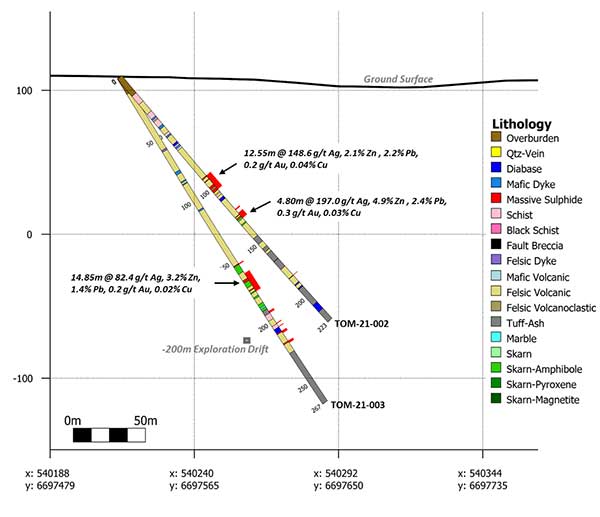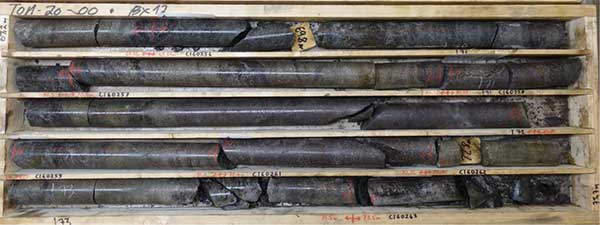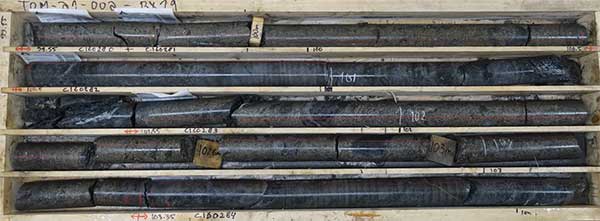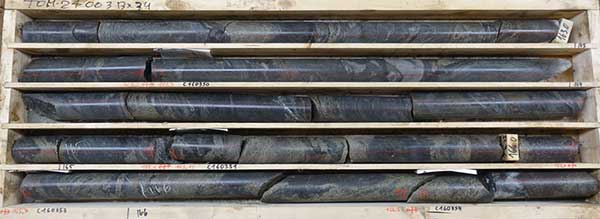District Intersects 8.2 m at 10.3% Zinc, 4.5% Lead, 66.2 g/t Silver, 1.7 g/t Gold, and 0.08% Copper at Tomtebo Property
May 25, 2021 – District Metals Corp. (TSX-V: DMX) (FRA: DFPP); ("District" or the “Company”) is pleased to report assay results for the first three drill holes from the maiden drilling program at the high grade polymetallic Tomtebo Property located in the Bergslagen Mining District in south-central Sweden.
The first three drill holes at Tomtebo have successfully encountered significant semi-massive to massive polymetallic sulphides. Drill hole TOM21-001 was drilled at the Steffenburgs zone, and holes TOM21-002 and -003 targeted the Oscarsgruvan zone with the following drill assay highlights:
- TOM21-001 intersected 8.2 m at 10.3% Zn, 4.5% Pb, 66.2 g/t Ag, 1.7 g/t Au, and 0.08% Cu (65.3 to 73.5 m) including 3.2 m at 17.8% Zn, 8.3% Pb, 124.4 g/t Ag, 1.6 g/t Au and 0.07% Cu (70.3 to 73.5 m).
- TOM21-002 intersected 12.55 m at 148.6 g/t Ag, 2.1% Zn, 2.2% Pb, 0.2 g/t Au, and 0.04% Cu (90.8 to 103.35 m) including 4.75 m at 198.5 g/t Ag, 4.5% Zn, 3.1% Pb, 0.3 g/t Au, and 0.04% Cu (98.6 to 103.35 m); and 4.8 m at 197.0 g/t Ag, 4.9% Zn, 2.4% Pb, 0.3 g/t Au, and 0.03% Cu (125.0 to 129.80 m).
- TOM21-003 intersected 14.85 m at 82.4 g/t Ag, 3.2% Zn, 1.4% Pb, 0.2 g/t Au, and 0.02% Cu (161.3 to 176.15 m) including 7.8 m at 117.6 g/t Ag, 3.5% Zn, 1.9% Pb, 0.3 g/t Au, and 0.02% Cu (163.3 to 171.1 m) and including 2.95 m at 74.2 g/t Ag, 6.2% Zn, 1.3% Pb, 0.2 g/t Au, and 0.03% Cu (173.2 to 176.15 m).
Drill hole locations, and a cross section at the Oscarsgruvan zone are shown in Figures 1 to 2, drill core photos are shown in Figures 3 to 5, and drill assay results are shown in Table
Rodney Allen, Technical Advisor for District, commented: “The first drill hole in the 2021 program provides an excellent intersection of the Zn-Pb-Ag massive sulphide mineralization at Tomtebo and is a giant step forward in understanding the Tomtebo mineral system. This drill hole provides the critical information that confirms the nature of the targets in the Tomtebo area, which in turn enables us to interpret where new undiscovered polymetallic lenses most likely occur. In particular, the intersection in hole one confirms that:
- This target is a volcanogenic massive sulphide (VMS) lens that occurs at a specific level of the volcanic host stratigraphy, above a large volume of intensely altered and vein-mineralized footwall rocks, and below a succession of less altered hanging-wall rocks.
- This style of massive sulphide lens has the potential to comprise a large volume of high-grade polymetallic sulphide.
- VMS lenses of this type always occur as clusters of massive sulphide lenses, scattered along the favourable stratigraphic “horizon”, which means there are more polymetallic sulphide lenses to be discovered in the Tomtebo system.
- VMS mineral systems typically comprise polymetallic sulphide lenses with roots that grade downwards into pyritic copper-bearing stockwork vein and disseminated mineralization that represents the “feeder” conduits to the massive sulphide. Consequently, we can now interpret the old open-pit copper prospects on the Tomtebo property as part of the stockwork of veins that fed the polymetallic massive sulphide mineralization higher in the stratigraphic sequence.
The second and third holes in the program intersected volcanogenic massive sulphide mineralization about 175 m northeast of hole one. The mineralization here comprises a combination of massive sulphide veins within altered volcanic rocks, and massive, semi-massive and disseminated polymetallic sulphide mineralization within, and at the contacts of, skarn-altered limestone beds. This indicates a second type of target, somewhat different to that in hole one, in which mineralizing hydrothermal solutions moved up through the volcanic stratigraphy, forming a stockwork of sulphide veins, and where the solutions met chemically reactive limestone beds, they spread out laterally along the contacts of the limestone, forming skarn in the limestone and mineralizing both the volcanic rock and the skarn. This is a similar style of mineralization to that at the nearby giant Garpenberg mine, and indicates that at Tomtebo there is volcanogenic massive sulphide mineralization both within volcanic rocks at the “favourable VMS mineralized horizon”, and also associated with limestone beds that may occur near or slightly below the “VMS horizon”.”
Garrett Ainsworth, CEO of District, commented: “By any metric the high grades of polymetallic mineralization we have encountered over significant widths in our first three drill holes at Tomtebo have clearly exceeded our expectations. We are especially pleased to see significant silver and gold grades as high as 1,430 g/t Ag and 7.4 g/t Au from discrete drill core samples returned from the Steffenburgs and Oscarsgruvan zones, which is important as almost 50% of the 2020 revenue from Boliden’s highly productive polymetallic Garpenberg Mine was attributed to silver and gold. Our high grade polymetallic mineralized drill intercepts remain wide open at depth and along strike, which sets us up to expand mineralization with follow up drilling.”
All three drill holes returned low concentrations of deleterious elements and dominantly coarse-grained polymetallic sulphides, which are favourable attributes from a metallurgical standpoint. These positive characteristics are consistent with other polymetallic mines in the Bergslagen Mining District. Deleterious elements associated with the polymetallic mineralization reported in this news release include arsenic (0.5 to 363 ppm), cadmium (0.02 to 516 ppm), antimony (0.28 to 1,470 ppm), and selenium (1 to 22 ppm). Coarse grained polymetallic sulphides are an important factor in obtaining high recoveries during mineral processing.
Drill Hole Summaries
TOM21-001 (Steffenburgs zone):
Hole TOM21-001 was drilled at an angled orientation (-45° dip) to the east (77° azimuth). It was designed to test the 3D modeled mineralized domain anchored by historic hole TOMT43002, which returned 6.2 m (41.7 to 47.9 m) at 11.22% Zn, 5.16% Pb, and 0.19% Cu (not assayed for silver and gold).
After 20.0 m of overburden, the hole intersected moderately altered felsic volcanic rocks with trace pyrite from 20.0 to 37.0 m intercalated by meter-scale mafic dykes from 24.7 to 34.4 m. Moderately altered felsic rock with increasing pyrite and gahnite content was intersected between 37.0 to 64.2m. The onset of stronger silicification of the felsic volcanic rock after 64.2 m marks the beginning of extensive sulphides which were intersected from 64.2 to 73.95m that included dense accumulations of disseminated, stringer, vein, and semi-massive to massive polymetallic mineralization. This mineralized unit includes a massive sulphide interval between 70.3 to 73.5 m. This substantial mineralized intercept is underlain by moderately to strongly altered felsic volcanic rocks intercalated by meter-scale mafic dykes from 76.2 m to the end of hole depth at 114.8 m. Hole TOM21-001 represents the strongest and most extensive mineralization intersected at the historic Tomtebo Mine to date.
TOM21-002 (Oscarsgruvan zone):
Hole TOM21-002 was drilled at an angled orientation of (-50° dip) to the northeast (30° azimuth), and was designed to test the 3D model mineralized domain anchored by historic hole TOMT65002, which returned 4.45 m (116.35 to 120.80 m) at 195.11 g/t Ag, 7.8% Zn, 3.0% Pb, 0.55 g/t Au, and 0.05% Cu.
After 15.6 m of overburden, the hole intersected moderately to strongly altered felsic volcanic rocks with disseminated trace pyrite intercalated by several meter-scale mafic dykes from 15.6 to 90.8 m. Numerous significant intervals of polymetallic sulphide mineralization were encountered between 90.8 to 103.55 m, 125.0 to 129.8 m, and 176.3 to 188.5 m within moderately to strongly altered felsic volcanic rocks intercalated by rare meter-scale limestone skarn units between 128.5 and 133.6m and mafic dykes. This mineralized unit includes a massive sulphide interval between 98.6 to 100.5 and 101.5 to 203.6 m. These significant polymetallic sulphide intercepts are underlain by weakly altered felsic volcanic rocks intercalated by narrow to meter-scale mafic dykes from 191.9 m to the end of hole depth at 223.0 m.
TOM21-003 (Oscarsgruvan zone):
Hole TOM21-003 was drilled at an angled orientation of (-59° dip) to the northeast (30° azimuth) and was primarily designed to test mineralization beneath hole TOM21-002. A secondary objective was to test the 3D model mineralized domain anchored by historic hole TOMT71024 which was drilled horizontally to the northwest from the -200 m exploration drift, and returned 4.45 m (22.59 to 27.04 m) at 55.96 g/t Ag, 8.73% Zn, 1.66% Pb, 0.24 g/t Au, and 0.03% Cu.
After 12.8 m of overburden, the hole intersected moderately to strongly altered felsic volcanic rocks with occasional disseminated pyrite intercalated by several meter-scale mafic dykes from 12.8 to 152.3 m. Numerous intervals of significant polymetallic sulphide mineralization were encountered between 152.3 to 218.8 m within strongly to intense altered felsic volcanic rocks intercalated by meter-scale limestone skarn units and a mafic dyke. This polymetallic mineralization was underlain by a weakly to moderately altered felsic volcanic rocks with disseminated pyrite from 218.8 m to the end of hole depth at 267.0 m.
Figure 1: Plan View Drill Holes at Tomtebo Mine
Figure 2: Cross Section Looking West at Oscarsgruvan Zone
Table 1: Tomtebo Drill Assay Results
| Drill Hole | Depths and Interval | Assay Results | |||||||||
| Hole ID | Azimuth | Dip | Total Depth (m) | From (m) | To (m) | Interval (m) | Ag (g/t) | Zn (%) | Pb (%) | Au (g/t) | Cu (%) |
| TOM21-001 | 77 | -45 | 114.80 | 36.70 | 37.90 | 1.20 | 24.30 | 0.19 | 0.01 | 0.65 | 0.84 |
| 47.30 | 59.00 | 11.70 | 7.59 | 0.82 | 0.47 | 0.08 | 0.07 | ||||
| 62.00 | 73.95 | 11.95 | 46.91 | 7.24 | 3.09 | 1.18 | 0.10 | ||||
| incl. | 65.30 | 73.50 | 8.20 | 66.21 | 10.33 | 4.46 | 1.67 | 0.08 | |||
| incl. | 70.30 | 73.50 | 3.20 | 124.39 | 17.80 | 8.26 | 1.63 | 0.07 | |||
| 80.80 | 81.70 | 0.90 | 10.60 | 0.70 | 0.46 | 0.06 | 0.03 | ||||
| TOM21-002 | 30 | -50 | 223.00 | 90.80 | 103.35 | 12.55 | 148.62 | 2.14 | 2.20 | 0.20 | 0.04 |
| incl. | 98.60 | 103.35 | 4.75 | 198.51 | 4.49 | 3.08 | 0.31 | 0.04 | |||
| 121.60 | 122.50 | 0.90 | 19.35 | 0.49 | 0.31 | 0.04 | 0.00 | ||||
| 125.00 | 129.80 | 4.80 | 196.96 | 4.94 | 2.36 | 0.30 | 0.03 | ||||
| 182.60 | 182.90 | 0.30 | 26.50 | 8.06 | 0.31 | 0.10 | 0.02 | ||||
| TOM21-003 | 30 | -59 | 267.00 | 153.35 | 154.15 | 0.80 | 15.40 | 2.09 | 0.18 | 0.02 | 0.04 |
| 161.30 | 176.15 | 14.85 | 82.35 | 3.22 | 1.36 | 0.21 | 0.02 | ||||
| incl. | 163.30 | 171.10 | 7.80 | 117.57 | 3.52 | 1.92 | 0.32 | 0.02 | |||
| incl. | 173.20 | 176.15 | 2.95 | 74.18 | 6.16 | 1.34 | 0.18 | 0.03 | |||
| 192.50 | 194.00 | 1.50 | 155.00 | 0.01 | 1.37 | 0.68 | 0.02 | ||||
| 202.30 | 202.80 | 0.50 | 16.25 | 2.31 | 0.77 | 0.11 | 0.01 | ||||
| 205.05 | 205.50 | 0.45 | 6.84 | 1.41 | 0.25 | 0.05 | 0.00 | ||||
| 208.90 | 210.65 | 1.75 | 37.20 | 4.97 | 1.34 | 0.18 | 0.00 | ||||
| 217.10 | 218.80 | 1.70 | 3.58 | 5.68 | 0.04 | 0.06 | 0.02 | ||||
Notes:
- All intervals are core lengths, and true thicknesses are yet to be determined. A mineral resource modeling is required before true thicknesses can be estimated.
- Cut-off grade of 50 g/t AgEq utilized, which may include up to 2.0 m of internal dilution. Underground mining cut-off at the nearby Garpenberg Mine was US$32/tonne in 2020.
- Metal prices used in USD for the AgEq cut-off calculation were based on Ag $15.00/oz, Au $1650/oz, Cu $2.15/lb, Zn $0.85/lb, and Pb $0.75/lb.
- The AgEq calculation assumes 100% recoveries to calculate the cut-off grades for exploration purposes.
Figure 3: TOM21-001 Sulphide Mineralization from 69.2 to 73.7 m
Figure 4: TOM21-002 Sulphide Mineralization from 99.6 to 104.1 m
Figure 5: TOM21-003 Sulphide Mineralization from 162.0 to 166.8 m
Technical Information
All scientific and technical information in this news release has been prepared by, or approved by Garrett Ainsworth, PGeo, President and CEO of the Company. Mr. Ainsworth is a qualified person for the purposes of National Instrument 43-101 - Standards of Disclosure for Mineral Projects.
The drill core reported in this news release was logged and prepared at the District Metals AB core facility in Säter, Sweden before submittal to ALS Geochemistry in Malå, Sweden where the drill core is cut, bagged, and prepared for analysis. Sample pulps were sent to ALS Geochemistry in Ireland (an accredited mineral analysis laboratory) for analysis. Samples were analyzed using a multi-element ultra trace method combining a four-acid digestion with ICP-MS analytical package (“ME-MS61”). Over limit sample values were re-assayed for: (1) values of zinc >1%; (2) values of lead >1%; and (3) values of silver >100 g/t using the high-grade material ICP-AES analytical package (“ME-OG62”). Additional over limit sample values were re-assayed for: (1) values of zinc >30%; (2) values of lead >20% using the high precision analysis of base metal ores AAS analytical package (“Zn, Pb-AAORE”). Gold, platinum, and palladium were analyzed using the 30 g lead fire assay with ICP-AES finish analytical package (“PGM-ICP23”). Certified standards, blanks, and duplicates were inserted into the sample shipment to ensure integrity of the assay process. Selected samples were chosen for duplicate assay from the coarse reject and pulps of the original sample. No QA/QC issues were noted with the results reported.
Some of the data disclosed in this news release is related to historical drilling results. District has not undertaken any independent investigation of the sampling nor has it independently analyzed the results of the historical exploration work in order to verify the results. District considers these historical drill results relevant as the Company is using this data as a guide to plan exploration programs. The Company's current and future exploration work includes verification of the historical data through drilling.
Mr. Ainsworth has not verified any of the information regarding any of the properties or projects referred to herein other than the Tomtebo Property. Mineralization on any other properties referred to herein is not necessarily indicative of mineralization on the Tomtebo Property.
About District Metals Corp.
District Metals Corp. is led by industry professionals with a track record of success in the mining industry. The Company’s mandate is to seek out, explore, and develop prospective mineral properties through a disciplined science-based approach to create shareholder value and benefit other stakeholders.
The advanced exploration stage Tomtebo Property is located in the Bergslagen Mining District of south-central Sweden is the Company’s main focus. Tomtebo comprises 5,144 ha, and is situated between the historic Falun Mine and Boliden’s Garpenberg Mine that are located 25 km to the northwest and southeast, respectively. Two historic polymetallic mines and numerous polymetallic showings are located on the Tomtebo Property along an approximate 17 km trend that exhibits similar geology, structure, alteration and VMS/SedEx style mineralization as other significant mines within the district. Mineralization that is open at depth and along strike at the historic mines on the Tomtebo Property has not been followed up on, and modern systematic exploration has never been conducted on the Property.
On Behalf of the Board of Directors
“Garrett Ainsworth”
President and Chief Executive Officer
(604) 288-4430
Neither TSX Venture Exchange nor its Regulation Services Provider (as that term is defined in policies of the TSX Venture Exchange) accepts responsibility for the adequacy or accuracy of this release.
Cautionary Statement Regarding “Forward-Looking” Information.
This news release contains certain statements that may be considered “forward-looking information” with respect to the Company within the meaning of applicable securities laws. In some cases, but not necessarily in all cases, forward-looking information can be identified by the use of forward-looking terminology such as “plans”, “targets”, “expects” or “does not expect”, “is expected”, “an opportunity exists”, “is positioned”, “estimates”, “intends”, “assumes”, “anticipates” or “does not anticipate” or “believes”, or variations of such words and phrases or statements that certain actions, events or results “may”, “could”, “would”, “might”, “will” or “will be taken”, “occur” or “be achieved” and any similar expressions. In addition, any statements that refer to expectations, predictions, indications, projections or other characterizations of future events or circumstances contain forward-looking information. Statements containing forward-looking information are not historical facts but instead represent management’s expectations, estimates and projections regarding future events. Forward-looking statements in this news release relating to the Company include, among other things, statements relating to the Company’s planned exploration activities, including its drill target strategy and next steps for the Tomtebo Property; the company’s interpretations and expectations about the mineralization of the Tomtebo mine; the Company’s belief that the numerous gravity high anomalies identified at the historic Tomtebo Mine provide immense expansion potential; the Company’s belief that the modeled gravity high anomalies at the historic Tomtebo Mine could correspond with polymetallic and/or iron sulphide mineralization, or a mafic unit; and the Company’s belief that the gravity high anomaly located one kilometer to the northeast of the Tomtebo Mine represents a potential grassroots discovery opportunity with a modeled tonnage that compares with the historic production tonnage from the historic Falun Mine.
These statements and other forward-looking information are based on opinions, assumptions and estimates made by the Company in light of its experience and perception of historical trends, current conditions and expected future developments, as well as other factors that the Company believes are appropriate and reasonable in the circumstances, as of the date of this news release, including, without limitation, assumptions about the reliability of historical data and the accuracy of publicly reported information regarding past and historic mines in the Bergslagen district; the Company’s ability to raise sufficient capital to fund planned exploration activities, maintain corporate capacity and satisfy the exploration expenditure requirements required by the definitive purchase agreement between the Company and the vendor of the Tomtebo Property (the "Definitive Purchase Agreement") by the times specified therein; and stability in financial and capital markets.
Forward-looking information is necessarily based on a number of opinions, assumptions and estimates that, while considered reasonable by the Company as of the date such statements are made, are subject to known and unknown risks, uncertainties, assumptions and other factors that may cause the actual results, level of activity, performance or achievements to be materially different from those expressed or implied by such forward-looking information, including but not limited to risks associated with the following: the reliability of historic data regarding the Tomtebo Property; the Company’s ability to raise sufficient capital to finance planned exploration (including incurring prescribed exploration expenditures required by the Definitive Purchase Agreement, failing which the Tomtebo Property will be forfeited without any repayment of the purchase price); the Company’s limited operating history; the Company’s negative operating cash flow and dependence on third-party financing; the uncertainty of additional funding; the uncertainties associated with early stage exploration activities including general economic, market and business conditions, the regulatory process, failure to obtain necessary permits and approvals, technical issues, potential delays, unexpected events and management’s capacity to execute and implement its future plans; the Company’s ability to identify any mineral resources and mineral reserves; the substantial expenditures required to establish mineral reserves through drilling and the estimation of mineral reserves or mineral resources; the Company’s dependence on one material project, the Tomtebo Property; the uncertainty of estimates used to calculated mineralization figures; changes in governmental regulations; compliance with applicable laws and regulations; competition for future resource acquisitions and skilled industry personnel; reliance on key personnel; title matters; conflicts of interest; environmental laws and regulations and associated risks, including climate change legislation; land reclamation requirements; changes in government policies; volatility of the Company’s share price; the unlikelihood that shareholders will receive dividends from the Company; potential future acquisitions and joint ventures; infrastructure risks; fluctuations in demand for, and prices of gold, silver and copper; fluctuations in foreign currency exchange rates; legal proceedings and the enforceability of judgments; going concern risk; risks related to the Company’s information technology systems and cyber-security risks; and risk related to the outbreak of epidemics or pandemics or other health crises, including the recent outbreak of COVID-19. For additional information regarding these risks, please see the Company’s Annual Information Form, under the heading “Risk Factors”, which is available at www.sedar.com. These factors and assumptions are not intended to represent a complete list of the factors and assumptions that could affect the Company. These factors and assumptions, however, should be considered carefully. Although the Company has attempted to identify factors that would cause actual actions, events or results to differ materially from those disclosed in the forward-looking statements or information, there may be other factors that cause actions, events or results not to be as anticipated, estimated or intended. Also, many of such factors are beyond the control of the Company. Accordingly, readers should not place undue reliance on forward-looking statements or information. The forward-looking information is made as of the date of this news release, and the Company assumes no obligation to publicly update or revise such forward-looking information, except as required by applicable securities laws. All scientific and technical information contained in this news release has been prepared by or reviewed and approved by Garrett Ainsworth, PGeo, President and CEO of the Company. Mr. Ainsworth is a qualified person for the purposes of National Instrument 43-101 - Standards of Disclosure for Mineral Projects





